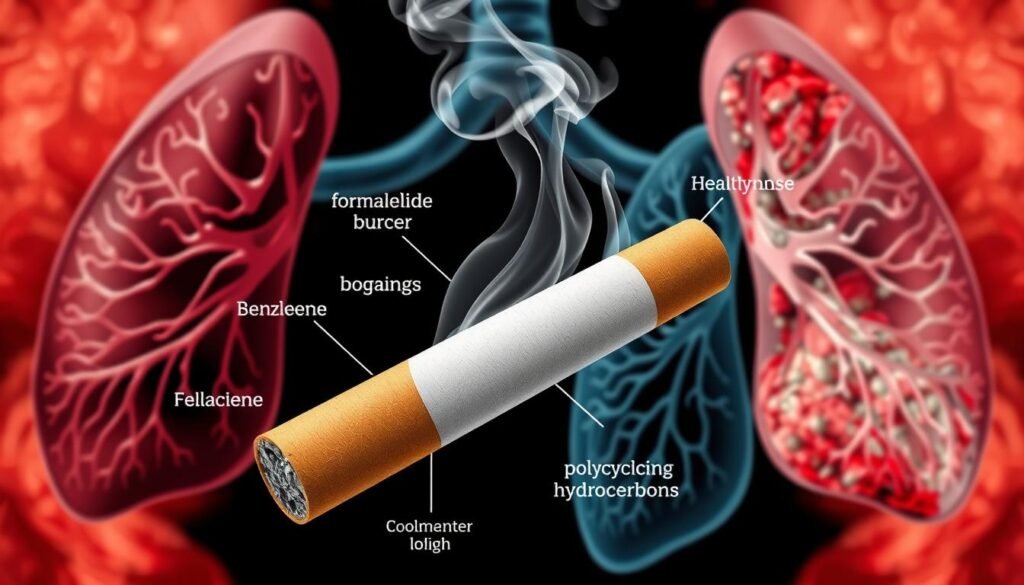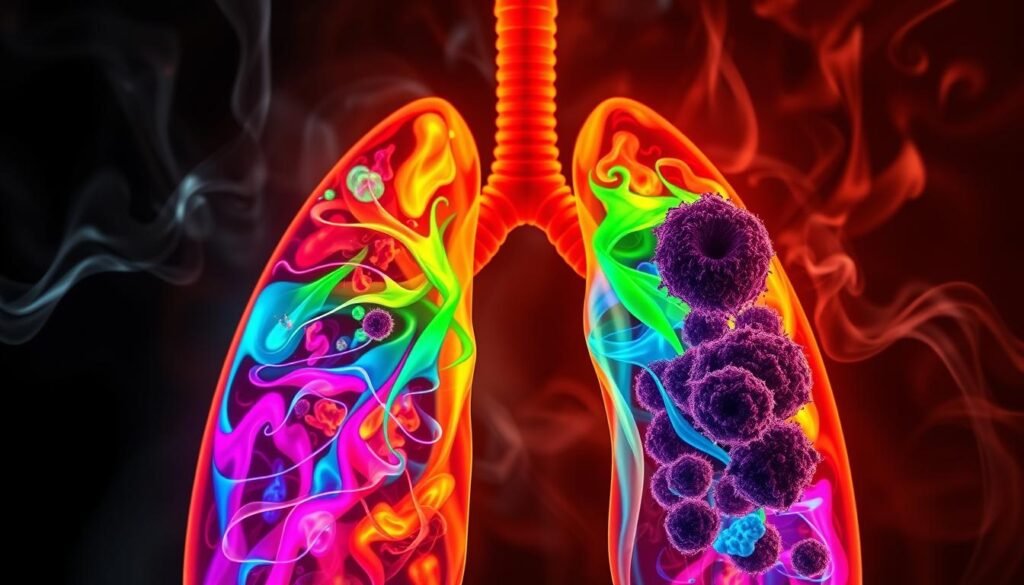Cigarette smoking causes about 80% to 90% of lung cancer deaths in the United States. It’s startling how much smoking increases lung cancer risk. Smokers are much more likely, 15 to 30 times in fact, to get lung cancer than nonsmokers. Cigarettes are dangerous because they have over 70 chemicals that can cause cancer.
The connection between smoking and lung cancer is clear. Studies show these carcinogens can change important genes in our bodies. These changes can turn on cancer genes and turn off protection against tumors. The bad chemicals in smoke can stick to our DNA. This can start the path to cancer, showing us why it’s important to know about these dangers.
It’s key to understand how cigarettes lead to lung cancer. Knowing about the harmful chemicals in smoke can help us see the risks of smoking. This knowledge can push us to prevent or stop smoking for our health.
Key Takeaways
- Cigarette smoking accounts for 80% to 90% of lung cancer deaths in the U.S.
- Smokers are 15 to 30 times more likely to develop lung cancer compared to non-smokers.
- At least 70 chemicals in tobacco smoke are known to cause cancer.
- Carcinogens must undergo metabolic activation to bind to DNA and form DNA adducts.
- Understanding carcinogens aids in recognizing lung cancer risks in smokers.
The Link Between Smoking and Lung Cancer
Smoking is a key cause of lung cancer. Nearly 90% of lung cancer in men and 70 to 80% in women is due to smoking. After age 40, women smokers more likely die from lung cancer than breast cancer.
Each year, over 1 million people worldwide die from lung cancer. It’s the top cancer killer globally. In the U.S., it causes more than 160,000 deaths every year. Smokers have a 30 times higher risk of lung cancer than non-smokers. Lung cancer is behind 31% of cancer deaths in men and 26% in women.
Only 15% of lung cancer patients live five years after finding out they have it. The one-year survival rate is a bit better, at about 42%. Lung cancer kills more people than prostate, colon, pancreas, and breast cancers together. This shows how deadly it is.
The tobacco industry keeps making money, but the terrible effects of smoking can’t be ignored. Studies show smoking causes inflammation that leads to lung cancer and other diseases. Quitting smoking is super important because of all the dangers it brings.
Understanding Carcinogens in Cigarette Smoke
Cigarette smoke is full of over 7,000 chemicals. More than sixty of these are known carcinogens. Substances like benzo[a]pyrene and various nitrosamines can mess with DNA. This might lead to cancer. The toxic mix greatly ups the risk of lung cancer, causing over a million deaths worldwide each year.
https://www.youtube.com/watch?v=gwuwrRK-I2Y
Key culprits in tobacco include tobacco-specific nitrosamines. They interact with cells in ways that help tumors grow. This happens through increased cell growth and less cell death. Smoking also causes inflammation, which can make tumor growth more likely. This shows why it’s critical to educate the public on the dangers of smoking as it continues to harm many people.
| Component of Cigarette Smoke | Type | Health Impact |
|---|---|---|
| Benzo[a]pyrene | Carcinogen | DNA mutations, lung cancer risk |
| Tobacco-specific nitrosamines | Carcinogen | Tumor promotion, binding to cellular receptors |
| Formaldehyde | Harmful Chemical | Respiratory issues, cancer risk |
| Acrolein | Harmful Chemical | Lung irritation, cancer risk |
| Carbon monoxide | Harmful Chemical | Reduced oxygen delivery, cardiovascular damage |
Avoiding these harmful chemicals helps decrease the risk of tobacco-related diseases. The link between cigarette carcinogens and lung cancer shows the need for health check-ups and quitting smoking. Knowing about these risks can help people choose a healthier lifestyle and lower their cancer risk.
For more about smoking and its health effects, visit this resource.
Role of Tar in Lung Cancer Development
Tar in cigarettes is a key factor in lung cancer. It forms when tobacco burns. It releases harmful chemicals, many known as carcinogens. These substances build up in the lungs and harm tissues over time.
About 80% of lung cancer deaths are from smoking. This shows tar’s big role in cancer. Studies link tar exposure to a higher lung cancer risk. This is true for various types, like small cell and large cell cancers. The risk increases with the number of cigarettes smoked over the years.
Smoking high-tar cigarettes is worse. Smokers of non-filtered cigarettes with 22 mg of tar or more face more lung cancer risk. This shows the effect of tar depending on the type of cigarettes smoked.
Tar also causes inflammation and changes in lung cells’ genes. These changes can lead to cancer. As tar piles up, it makes the lungs a toxic place. This not only leads to cancer but also worsens other health issues.
The role of tar in causing lung cancer is huge. More tar means more risk of lung cancer. Knowing how tar leads to cancer helps smokers make healthier choices. It helps them focus on their lung health.
What in Cigarettes Causes Lung Cancer
Lung cancer is a top cause of cancer deaths globally, mostly due to smoking. It’s key to know the major carcinogens in cigarette smoke fueling this disease. They play a big role in lung cancer’s emergence.
Major Carcinogens Present in Cigarette Smoke
Cigarette smoke is packed with major carcinogens. Key culprits include polycyclic aromatic hydrocarbons (PAHs) and tobacco-specific nitrosamines. These cause lung cancer and other health problems. Smoking is linked to about 80% of lung cancer deaths, making it a primary risk factor. Being near radon gas and asbestos raises this risk even more. For a closer look at how these elements tie to lung cancer, see this resource.
How Carcinogens Interact with DNA
The way carcinogens mix with DNA is alarming. When inhaled, they attach to DNA and may mutate it. Take benzo[a]pyrene as an example. It wrecks DNA functions and leads to cancer. Avoiding cigarette smoke is crucial to lower cancer risk.

Nicotine: The Addictive Element
Nicotine is the main reason people find it hard to quit smoking. It makes giving up the habit tough for many. While nicotine isn’t a cancer-causing agent, it leads to serious health problems with long-term use. This includes lung cancer due to tobacco.
Tobacco items, such as e-cigarettes and cigars, all contain nicotine. Cigarettes are more problematic because they mix nicotine with over 7,000 chemicals. This mix not only makes nicotine addiction worse but also makes it harder to stop smoking. Luckily, FDA-approved nicotine replacement therapies (NRTs) help people quit. They can double someone’s chances of giving up smoking for good.
Teens are especially at risk of getting hooked on nicotine. It affects their growing brains. Also, nicotine can harm unborn babies, which is worrying for pregnant smokers. Reducing nicotine in cigarettes to low or non-addictive levels could help. It might lower smoking rates and prevent addiction in young folks.
It’s key to understand nicotine’s role to stop smoking effectively. We need to tackle its addictive nature and harmful effects. This way, we can fight against tobacco-related health risks.
Carbon Monoxide: Effects on Lung Health
Carbon monoxide in cigarette smoke is a big hazard, especially to lung health. This toxic gas harms how the body carries oxygen. When we breathe it in, it latches onto our red blood cells. This reduces their ability to carry oxygen. Organs and tissues then struggle to get enough oxygen, causing lasting damage.
People with lung problems are at higher risk. Carbon monoxide makes issues like asthma and COPD worse. In fact, 80% of COPD deaths are from smoking. This shows how dangerous smoke’s byproducts are.
Carbon monoxide exposure can give you flu-like symptoms. These include headaches, dizziness, and weakness. These symptoms might not seem serious at first. But over time, exposure can lead to confusion and even long-term mental and physical problems. The risk of lung cancer also goes up for smokers. This risk is even higher with carbon monoxide and other toxins in smoke. This is why it’s so important to avoid smoking.

Secondhand Smoke and Lung Cancer Risks
Secondhand smoke is dangerous for people who don’t smoke, especially kids and pregnant women. It has over 7,000 chemicals, including 69 that cause cancer. This shows how being around smoke can cause lung cancer.
Studies show secondhand smoke can cause lung cancer in people who don’t smoke. Adults who avoid tobacco but are exposed to smoke have a 20% to 30% higher risk of getting lung cancer. Every year, more than 7,300 non-smokers die from lung cancer because of secondhand smoke.
Children breathing in secondhand smoke face serious health problems. They are more likely to get infections, asthma, and sudden infant death syndrome (SIDS), a leading cause of death in healthy infants. Adults exposed to smoke have a higher risk of getting breast cancer and other cancers, too.
Laws have helped reduce these health risks. In the U.S., smoke-free laws have cut down on secondhand smoke for non-smokers. This includes bans on smoking in flights and public buildings. Many countries now have similar rules for smoke-free workplaces, restaurants, and bars.
The cost of health problems from secondhand smoke is huge, with billions lost in productivity. Raising awareness is key to creating smoke-free places. This helps protect everyone’s health.
The Role of Chronic Inflammation in Lung Cancer
Chronic inflammation is key in the development of lung cancer. It often starts from smoking, leading to more risks. People who smoke keep facing inflammation that hurts their lung tissues. This constant damage attracts immune cells. These cells produce harmful oxygen species that can damage DNA and start cancer.
About 80% to 90% of lung cancer deaths in the U.S. are due to smoking. Diseases like Chronic Obstructive Pulmonary Disease (COPD) make these risks higher. People with COPD have different immune reactions, increasing lung cancer risks. Smoking can mess up the immune system. It makes regulatory T cells work less well, leading to more inflammation and cancer.
Studies on chronic inflammation are moving forward. Researchers are looking at anti-inflammatory drugs, like canakinumab, to lower lung cancer risks from chronic inflammation. Eating well and exercising regularly can help manage inflammation. These steps also help with recovery from cancer.

Impact of Other Risk Factors for Lung Cancer
Even though cigarette smoking causes most lung cancer cases, we can’t ignore other risk factors. Environmental risks are also crucial. For example, radon exposure leads to 21,000 lung cancer deaths each year in the U.S. It’s the second leading cause after smoking. Alarmingly, one out of every 15 homes could have high radon levels.
Asbestos exposure, especially at work, raises the risk of lung cancer. It’s linked to 70% to 80% of mesothelioma cases. Being around hazardous chemicals like arsenic and various petroleum products also poses a risk. Poor air quality affects many, as one in three Americans lives where air pollution is unhealthy.
Genetics play a big part in lung cancer risk too. If lung cancer runs in your family, your risk might double. This risk increases with two or more first-degree relatives affected. Also, if you’ve had chest radiation therapy for other diseases, your lung cancer risk goes up.
It’s vital to understand these other risk factors for lung cancer. Knowing about environmental risks and genetic predisposition helps us make better choices for our health.
| Risk Factor | Impact on Lung Cancer Risk |
|---|---|
| Smoking | Accounts for approximately 90% of cases |
| Radon Exposure | Second leading cause; about 21,000 deaths annually |
| Asbestos Exposure | 70% to 80% of mesothelioma cases are linked |
| Hazardous Chemicals | Increased risk from substances like arsenic and cadmium |
| Genetic Predisposition | Family history can double the risk |
| Air Pollution | One in three Americans live in unhealthy air conditions |
Smoking Cessation and Its Benefits
Quitting smoking improves lung health and overall well-being greatly. It cuts the risk of serious diseases linked to smoking.
Stopping smoking before turning 40 reduces death risk from smoking-related diseases by up to 90%. Quitting can add up to 10 years to your life. It also lowers cancer risk in organs like the stomach, liver, and colon, including acute myeloid leukemia.
Quitting smoking brings immediate benefits. Tastes and smells become stronger, breath smells better, and teeth and nails get less yellow. Quitting also means saving the money you’d spend on tobacco. In the long run, your lungs work better, and you won’t get out of breath as quickly. This makes enjoying life in smoke-free places easier.
Reducing how many cigarettes you smoke can lower lung cancer risk by 20%. Cutting down on smoking leads to fewer lung cancer cases over time. If you quit, you’re much less likely to get lung cancer compared to those who keep smoking.
- Immediate benefits of quitting smoking:
- Saving money previously spent on tobacco
- Improved taste and smell
- Better breath and grooming
- Enhanced lung function
- Long-term health benefits:
- Lower risk of lung cancer and other cancers
- Increased lifespan
- Ability to be in smoke-free environments comfortably
Choosing to quit smoking is a big step toward a healthier life. The mix of quick and long-term health gains shows how quitting smoking is good for you. It doesn’t just make you live longer. It also makes daily life better, leading to a happy, smoke-free life.
Research on Tobacco-Specific Carcinogens
Studying tobacco-specific carcinogens is key to tackling lung cancer’s health crisis. These harmful substances come only from tobacco. One type, nitrosamines, gets created during the tobacco curing process. They are linked to many cancers, including lung cancer.
Current research looks closely at how these carcinogens affect our bodies. Findings show a clear link between them and a higher risk of lung cancer in smokers. In fact, cigarette smoking causes 90% of lung cancer deaths worldwide. This highlights the severe impact of smoking.
Studying the toxic parts of cigarette smoke shows us the need for better treatments and prevention. Scientists are learning how these substances interact with our bodies. This knowledge helps us find ways to lessen tobacco’s harm. Click here for a detailed report.
Learning more about tobacco’s risks can shape health policies and actions. The connection between allergies and lung cancer is being explored too. This research may lead to new ways to fight tobacco-related diseases. For more information, click here.
| Carcinogen Type | Source | Linked Outcomes |
|---|---|---|
| Tobacco-Specific Nitrosamines | Cured Tobacco Products | Lung Cancer |
| Polycyclic Aromatic Hydrocarbons (PAHs) | Tobacco Smoke | Various Cancers |
| Aromatic Amines | Tobacco Smoke | Bladder Cancer |
| Formaldehyde | Cigarette Smoke | Nasal Cancers |
| Benzene | Tobacco Smoke | Leukemia |
Conclusion
The link between smoking cigarettes and lung cancer is very strong. Cigarette smoke has harmful things like tar, nicotine, and carbon monoxide. These make the danger of smoking very clear.
Even though fewer people are dying from lung cancer, it still causes about 1.5 million deaths worldwide each year. This shows how important it is for everyone to know about these risks. Over half of the facts in the 1964 Surgeon General’s report were based on detailed studies. They proved smoking is bad for lung health.
Even though lung cancer rates are getting a bit better, 95% of these deaths could be avoided. This shows how vital it is to quit smoking. Telling people about the risks of smoking is key to stopping this disease in the future.
While more people have been smoking over the years, we see a chance for change. Society can take steps to prevent these needless deaths.
To sum up, protecting our lungs starts with knowing how smoking is harmful. With new studies continuously showing the dangers, it’s important for everyone to work together. We need to make smart choices about tobacco to keep people healthy for years to come.